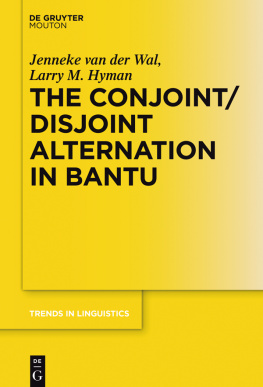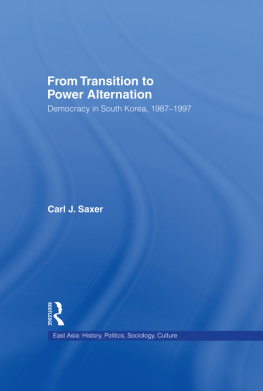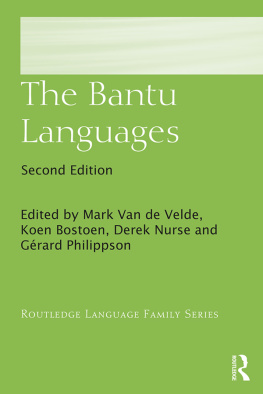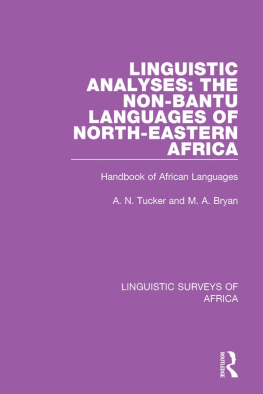Table of contents
Guide

Jenneke van der Wal and Larry M. Hyman (Eds.)
The Conjoint/Disjoint Alternation in Bantu
Trends in Linguistics Studies and Monographs

Editor
Volker Gast
Editorial Board
Walter Bisang
Jan Terje Faarlund
Hans Henrich Hock
Natalia Levshina
Heiko Narrog
Matthias Schlesewsky
Amir Zeldes
Niina Ning Zhang
Editors responsible for this volume
Walter Bisang und Volker Gast
Volume 301

ISBN 978-3-11-048838-8
e-ISBN (PDF) 978-3-11-049083-1
e-ISBN (EPUB) 978-3-11-048842-5
ISSN 1861-4302
Library of Congress Cataloging-in-Publication Data
A CIP catalog record for this book has been applied for at the Library of Congress.
Bibliographic information published by the Deutsche Nationalbibliothek
The Deutsche Nationalbibliothek lists this publication in the Deutsche Nationalbibliografie; detailed bibliographic data are available on the Internet at http://dnb.dnb.de.
2017 Walter de Gruyter GmbH, Berlin/Boston
www.degruyter.com
Preface
In the Spring of 2013 the two editors discovered that we had both perceived the need for a synthesis of the widespread Bantu phenomenon of what Meeussen (1959) had first identified as the conjoint/disjoint (cj/dj) alternation. Although other studies following Meeussen pointed out similar distinctions in other Bantu languages, often using different terms, we both noted that the reported cases could vary quite a bit from one language to another. We had independently written overview statements (which appear in revised form as of the present volume) which told only part of the story. Van der Wals was mostly concerned with the nature of the cj/dj distinction itself, how it varies across Bantu languages, and how it should be analyzed, e.g. whether as a manifestation of differences in information structure (focus) or constituency. Hyman was more concerned with determining the origins of the contrast, its relation to other Bantu phenomena involving the verb, and the immediate after verb (IAV) constituent. It was (and remains) clear to us that the cj/dj distinction has broad implications both for Bantu and general linguistics. Given the richness and variation in the realization of the cj/dj alternation, we agreed that the time had come to assemble the considerable knowledge and data that had amassed over the past decades and attempt to establish a reference point for subsequent research.
At the 5th International Conference on Bantu Languages in Paris (June 12-15, 2013) we agreed that it would be beneficial to the field if we collaborated in a published work that could provide such a reference point. With the goal of assembling a group of papers that would deal with the intricacies of the cj-dj phenomenon in different Bantu languages, we contacted a number of colleagues to see if they would be interested in participating. After a smooth though extended writing and reviewing period, and a joint editorial week in Berkeley, the first editor supported in part by Darwin College Cambridge, the result is the present volume.
We would like to thank all the authors for their careful work in writing their own and reviewing other chapters, and for their patience throughout the process. We are also very grateful to the anonymous external reviewer of the whole volume, and the external reviewers of the chapters: Thomas Bearth, Leston Buell, Brent Henderson, Michael Marlo, Maarten Mous, Fidle Mpiranya, Peter Muriungi, Malin Petzell, Grard Philippson, and John Watters.
Jenneke van der Wal
Larry M. Hyman
Contributors
Koen Bostoen
BantUGent - UGent Centre for Bantu Studies
Ghent University
E-Mail:
Toni Cook
University of KwaZulu-Natal, Durban
E-Mail:
Denis Creissels
Universit Lyon 2
E-Mail:
Maud Devos
Royal Museum for Central Africa
E-Mail:
Ines Fiedler
Humboldt University
Berlin
E-Mail:
Hannah Gibson
SOAS, University of London
E-Mail:
Claire Halpert
University of Minnesota
E-Mail:
Larry M. Hyman
University of California, Berkeley
E-Mail:
Andriana Koumbarou
SOAS, University of London
E-Mail:
Nancy C. Kula
University of Essex
E-Mail:
Sophie Manus
Laboratoire Dynamique du Langage
(CNRS) & Universit Lumire Lyon 2
E-Mail:
Lutz Marten
SOAS, University of London
E-Mail:
Yukiko Morimoto
Humboldt University of Berlin
E-Mail:
Jean Paul Ngoboka
University of KwaZulu-Natal Durban
E-Mail:
Ernest Nshemezimana
Ghent University
E-Mail:
Jenneke van der Wal
University of Cambridge
E-Mail:
Nobuko Yoneda
Osaka University
E-Mail:
Jochen Zeller
University of KwaZulu-Natal
Durban
E-Mail:
Sabine Zerbian
University of Stuttgart
E-Mail: .
uni-stuttgart.de
Jenneke van der Wal and Larry M. Hyman
1Introduction
In this introduction we highlight some of the recurring issues with respect to the conjoint/ disjoint (cj/dj) alternation and the results that can be drawn from the current volume. In .
1Bantu basics and the cj/dj alternation
Most of the languages discussed in this volume have SVO as a basic word order. In addition, they all distinguish up to 20 noun classes, as visible in the nominal morphology and the agreement and concord patterns in the phrase and clause. More relevant to the cj/dj alternation is the verbal inflectional morphology. As summarized below, based on Meeussen (1967), a Bantu verb root can be extended and inflected by multiple prefixes and suffixes:
These slots are illustrated in the Luganda verb in (1):
Luganda
As will become clear from the chapters in this volume, languages that display the cj/dj alternation inflect their verbs not just for TAM and polarity, but also for junctivity, that is, whether the verb takes a conjoint or disjoint form. This marking often interacts with the TAM segmental prefixes, suffixes and tones.
As an initial characterization, the Bantu cj/dj distinction refers to certain verb tenses which are marked with different allomorphs. These potentially correlate with differences in focus, constituent structure, and/ or phonological phrasing. The terms conjoint and disjoint were first used by Meeussen (1959) in his description of Kirundi. He noticed that some conjugations form pairs and described them as expressing a difference in the relation of the verb with the element following it. Hence the term conjoint (< French, linked) for a sequence of verb and postverbal element that is very close, and the term disjoint (separated, loose) for a structure in which the verb does not have such a close relation with a following element if one in fact follows the verb. Meeussen (1959) gives the examples in (2) as an illustration of the alternation.













